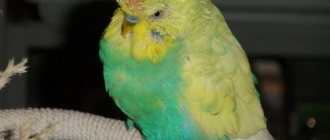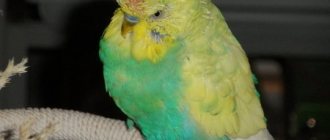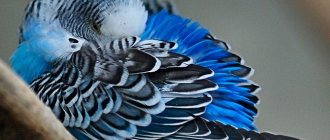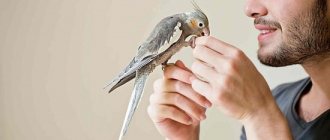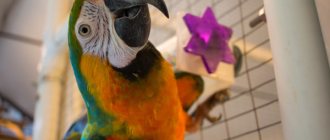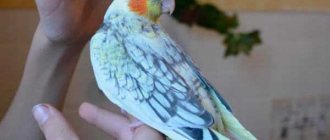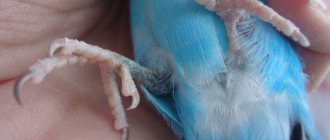The essence of the problem
The appearance of a parrot makes some adjustments to the breeder’s everyday life.
Proper care of birds requires daily cleaning of the enclosure, as well as changing water and food. Incorrect living conditions, lack of disinfection, imbalance in diet lead to various pet diseases. An inexperienced owner should know that after purchasing a parrot, the bird goes through an adaptation period. Depending on the nature and type of bird, this period takes different times. On average - 14 days.
Transportation, sudden changes in living conditions and usual food put the parrot under stress. All birds have different reactions to moving. Some people tolerate it easily, while others experience an attack of hyperactivity. At the same time, the parrot rushes around the cage and screams loudly.
In order for your pet to quickly get used to new conditions, the surrounding world and people, you need to ask the seller in advance what the parrot eats. The presence of a favorite treat in the cage can make the bird happy, which will help calm it down.
Description of the problem
Buying a parrot binds the owner with certain obligations to the bird. Activity and high metabolic rate require regular feeding, water changes and regular cleaning of the cage. If you do not take care of your bird in a timely manner, many health problems of a bacterial, infectious or autoimmune nature may arise. With an incorrectly formulated diet, various diseases also begin.
After purchase, the bird goes through a short adaptation period, up to two weeks. The duration may vary depending on the nature and species of the individual.
Description of the problem
If the bird is subjected to stress, for example, during transportation or changes in housing and nutritional conditions, severe depression may occur. To minimize the influence of external factors on your pet, it is advisable to regularly feed it with its favorite types of food.
Stress can cause changes in the bird's activity. Normally, parrots are energetic during the day and sleep at night. The bird moves and plays most of all in the morning. Therefore, if a wavy or cockatiel makes noise at night, you must be wary and find the cause of the atypical behavior. I will list the options below.
Reasons for parrot activity
- Adaptation to new conditions;
- Lack of free range;
- Nesting period;
- Gout.
If the bird lives in your house for a long time and is accustomed to its surroundings, then the appearance of hyperactivity may indicate a lack of free flights. At the same time, the parrot runs around the cage back and forth, trying to throw out energy. It is necessary to provide your pet with regular walks. Free range is a necessary requirement for keeping a feathered friend.
Another reason for the manifestation of symptoms may be the period of sexual activity. By its behavior, the parrot shows its readiness for nesting. The male is active and playful. When kept alone, the bird pays increased attention to its favorite toys. The bird makes chirping sounds and often moves its paws in one place. If parrots are kept in pairs, the birds express excited behavior to each other. At the same time, the parrot runs from side to side along the perch, pretending to dance. The feathers on the head rise at this time. The male takes care of his mate, cleans her feathers and brings her food.
The female shows increased activity during the laying period. She is preparing a place for future babies. Collects fragments suitable for soft and warm bedding. These could be pieces of paper or twigs. During its exciting actions it makes characteristic chirping sounds.
This manifestation of bird behavior is not considered a deviation from the norm. But the symptom of hyperactivity occurs in the disease Gout.
Gout
The disease occurs due to overeating homemade food from the table.
The disease can be recognized by characteristic nodules on the joints of the paws. This defect causes severe discomfort. The bird experiences pain when moving. Associated symptoms are:
- lethargy;
- constant presence at the bottom of the cage due to the inability to stand or sit on a perch;
- decreased appetite;
- at a later stage, loose and profuse stools appear.
During gout, your parrot may experience bouts of hyperactivity. The parrot runs along the bottom of the cage, makes various sounds, and then falls again and continues to sit lethargic and sick. The disease is difficult to tolerate. Due to the frequent manifestation of the disease, the disease becomes chronic.
To alleviate the pet's condition, vitamin complexes are included in the diet. The balance in food is clearly maintained. Protein foods of animal origin are excluded.
In severe cases of gout, surgical intervention is used to remove the nodules. During the procedure, a lump on the joint is pierced with a sterile needle and the accumulated fluid is squeezed out. Such actions make the life of the bird much easier.
A caring owner must clearly distinguish the nature of the hyperactivity symptom. If this is a temporary manifestation, then do not worry. It is necessary to pay more attention to the pet and understand what he wants to change. An active, energetic bird means healthy.
Why does a parrot make unpleasant noises?
Depending on the type of parrot, there may be different reasons for screaming. Their volume and intensity also vary.
Runs around the cage and screams
A bird may do this for the following reasons:
- wild and untamed individual;
- stress, anxiety, fear, feeling of danger;
- disease or parasites;
- change in living conditions or family composition;
- lack of food or water;
- an attempt to attract attention.
In addition, parrots do not like to be left alone and can react with loud sounds when their owner leaves the house.
Therefore, it is better to have several birds at once, and if there is only one pet, you should gradually accustom it to the fact that for some time it will be deprived of company. Many birds respond well if they are left with a radio turned on quietly.
Yells in the morning
The cry of birds in the morning is a completely natural phenomenon. The fact is that their greatest activity occurs in the early morning hours and before sunset. Therefore, the biological rhythms of parrots living at home completely coincide with the rhythms of their wild relatives.
The exception is situations when the length of daylight hours is artificially regulated. For example, if you put a blanket over a parrot's cage, then most likely there will be no usual morning cry.
Screams at night
If the parrot has recently appeared in the house and is not tamed, then any sounds or movements may frighten it. This is the headlights of a passing car, sounds outside the window, the cry of a night bird, the noise of a fan or the movement of curtains. The result of this is a strong cry, with which the bird expresses its fear and tries to scare away a potential enemy.
During this period, she may begin to rush around the cage, risking damage to feathers or wings. If this happens, you need to immediately turn on the light, calmly and affectionately talk to your pet, and offer him fresh water. It is also necessary to remove damaged feathers and treat these areas with a solution of hydrogen peroxide.
Natural and home conditions
Budgerigars are native to Australia. Under natural conditions, these birds have a lot to do: feed themselves and their offspring, find drinking water, and so on. To survive, parrots have to cross long distances, so they need a lot of strength. Sleeping at night helps you accumulate energy for future flights.
In addition, the Australian mainland has a unique climate - hot and humid. By the middle of the day, the air temperature rises so much that the parrots have to hide in the shade of trees, which also save them from attacks by predators. Parrots also spend the hot daytime time resting and gaining strength.
Domesticated parrots have the same natural instincts. If you see your pet sleeping during the day, don't worry - this habit is in their blood. However, in the wild, nature takes control of parrots’ sleep. Their owners should take care of how to sleep budgies at home.
The most noisy parrots: the nature of the cry and its reasons
Many bird owners note that the most noisy of them are cockatiels and budgies.
Corella screams all day long
Corellas are one of the most talkative species of parrots. Moreover, their sounds, already quite sharp, can develop into an almost unbearable scream.
Most often, this happens to wild or overly spoiled individuals.
- If you get a wild parrot, you need to be patient to train your feathered pet. Having gotten used to you and the new environment, he will begin to behave calmer.
- In the second case, only a competent reaction to his cry will help. You should not run into the room at the first call of the cockatiel - on the contrary, he must understand that they approach him, let him out for a walk, or give him food only when he behaves well. And such behavior should be encouraged in every possible way.
If you open the cage to let your bird out for a walk, you should do it before he starts screaming with impatience. Gradually, the cockatiel will understand that it is not at all necessary to scream heart-rendingly to get what you want.
And although its cry is not always pleasant to the ear, it must be remembered that this is a normal instrument of communication for birds. And the cockatiel is unlikely to remain absolutely silent.
Budgerigar screams loudly
Budgerigars, like all other birds, greet the sunrise with joyful chirping and see it off just as loudly at sunset.
There are several more types of their sound signals:
- melodious chirping - birds communicate with each other;
- an abrupt, sharp cry - indignation, discontent, quarrel with relatives;
- prolonged scream - extreme degree of indignation, fear;
- abrupt chirping - attracting attention, the desire to eat or leave the cage;
- singing with a little clicking - luring the female to the male.
In addition, the cry can be made from joy or boredom. Budgerigars also love to scream in flight, and nothing can be done about it.
How to behave with a parrot for the first time
At first, you need to take care of the bird's peace. There is no need to turn on loud music, turn on the vacuum cleaner and other loud household appliances, especially when she falls asleep. You should not make sudden movements in front of your pet's cage, as this may cause fright. First, open the cage only to clean it, add food or pour clean water. At first he will not speak and may open his beak without making a sound.
There is no need to try to pick up a wavy household member. He may get scared and even peck his owner. For the first week or even month, you can cover one side of the cage with a gauze cloth. The bird will have somewhere to hide and this way it will quickly get used to the situation.
How to stop a parrot from screaming
Before you try to wean your pet from screaming, you should determine its cause. To do this, it is worth observing him for some time and noting the situations in which he begins to scream.
It is best to record this data in table form.
- Date and time.
- Condition for a cry to occur.
- The nature and duration of the cry.
It is better to fill out the table over a long period of time, while simultaneously monitoring the health and appearance of the bird.
If you have any suspicions about possible illnesses, it is better to seek help from a specialist. Perhaps the reason for your pet's behavior is some kind of disease. In other cases, it is necessary to analyze the data obtained.
Morning screaming is normal, but if for some reason it is undesirable, you can simply reduce the bird's daylight hours by throwing a cloth over the cage. Then the parrot will be calm until you remove it.
The same measure will help get rid of night screaming. It will also allow you to regulate the bird’s sleep pattern so that its duration is 10 hours in summer and 12 hours in winter.
If the cause of screaming is stress, you should try to avoid situations that cause it. For example, many birds do not like too loud sounds or noisy companies.
One of the main reasons for screaming is the desire to attract the attention of its owner. Therefore, you need to try to spend as much time as possible with the bird so that it constantly feels your care and attention.
Sleeping mode
In order for a budgerigar to get enough sleep, the duration of its sleep in the summer should reach ten to twelve hours, and in the winter - twelve to fourteen hours.
In order not to harm the health of your feathered pet, you need to provide him with optimal conditions for rest. The budgie begins to fall asleep when it gets dark. For proper sleep, at the appropriate time it is necessary to cover the bird’s cage with a breathable, dense fabric. Thanks to this, she will decide that it is time to sleep.
In the summer, when it gets dark outside the window, cover the cage around nine o'clock in the evening. Then your pet will sleep for the prescribed ten to twelve hours. In winter, you will have to put the bird to bed earlier - between five and seven hours. And she will be able to sleep for about twelve to fourteen hours.
What not to do
Even if the cry of a parrot literally drives you crazy, under no circumstances should you do the following:
- beat the bird or the cage it is in;
- shout at her;
- splash water.
This behavior will not only not help, but will most likely harm your feathered friend. This will cause him to be even more stressed and the screaming will continue even longer.
So, now you know that the key to a well-behaved parrot is a calm environment in the house and the right conditions for keeping it. You should take good care of your pet, be attentive to its health and spend enough time with it - and then your feathered friend will bring you only joy.
Possible complications
Your feathered pet doesn't care about the fact that you have an irregular sleep schedule. You can go to bed at any time you want, but your bird needs to get enough sleep.
Due to the lights not being turned off at night and extraneous noise (TV, music, guests talking), the parrot cannot sleep. For proper bird sleep, the room where the cage hangs should be dark and quiet. If the “wavy” does not get enough sleep at night, he will sleep during the day.
If you do not take care of your pet’s physical and mental condition and ignore its needs, then it is unlikely that it will be healthy, cheerful and active. Due to chronic lack of sleep, a budgerigar may develop the following problems:
- unnatural loss of feathers;
- self-plucking;
- constant drowsiness and lethargy;
- state of apathy;
- nervousness;
- depression;
- aggression;
- lack of appetite;
- unplanned egg laying.
Why does the parrot run around the cage back and forth?
Before purchasing a feathered pet, you should familiarize yourself with the relevant literature on the care and behavioral characteristics of parrots. In case of improper care, illness or other factors affecting the condition of the bird, it may develop an atypical lifestyle - hyperactivity, or, conversely, lethargy. With an increase in the frequency of movements and constant noise, especially in the dark, owners have a question: why does the parrot rush around the cage at night? I will try to give the answer in the article.
Reasons for a parrot tossing around its cage
Possible reasons
The main factors why a parrot may behave unnaturally include:
- improper care;
- adaptation period;
- lack of walking;
- nesting time;
- gout.
Incorrect conditions of detention
If the bird runs around the enclosure and hits its walls, the problem may be due to stress. The reason may be the wrong location of the home, as a result of which the parrot gets scared and starts screaming loudly and rushing about.
Constant cell rearrangements may also be to blame. To get rid of the inconvenience, try returning or moving the enclosure to its original place.
Adaptation to new conditions
If the problem appeared immediately after the move, and the parrot runs around the cage at night, then it is simply getting used to its new place of residence. To speed up the adaptation process, try feeding your bird his favorite foods for a while. When purchasing and moving to a new habitat, it is better to check with the seller about the food preferred by birds.
No free range
This problem can arise if the bird lives with one breeder for a long period and is limited in flights due to the owner’s lack of time. The sudden onset of nocturnal hyperactivity, when the bird rushes back and forth around the cage, indicates the need for access to free range. To save your parrot from further depression, be sure to release it regularly into the wild.
Nesting period
If birds are ready to have offspring, they will chirp more, spend time with toys and their significant other. Throwing around the cage can occur when kept in pairs. The male pet begins to move around the enclosure, depicting the typical mating behavior of budgerigars - dancing.
The female is most active when laying eggs. She prepares the nest, while chirping loudly.
None of these symptoms are considered pathological. However, joint diseases, which are discussed below, can also lead to the appearance of such signs.
Gout
If a cockatiel, or any other parrot, is not fed correctly, adding, for example, fatty foods to the diet, nodules may form on the paws, which lead to severe pain when moving.
Typical symptoms for gout:
- The pet is lethargic for a long time.
- The bird is constantly at the bottom of the enclosure.
- He eats poorly or refuses food altogether.
- Loose stools may appear.
With gout, attacks of increased activity are common, when the bird begins to move along the bottom of the cage, then falls and settles. Parrots are very difficult to tolerate this disease.
To improve the condition, it is advisable to show your pet to an ornithologist veterinarian, who will make a diagnosis and prescribe specialized treatment. It usually includes multivitamin complexes, as well as a special diet.
Advice from experienced breeders
To stop your pet from screaming and thrashing, be sure to determine the root cause of the inappropriate behavior. To do this, watch the bird during the day. Note all the situations when he begins to behave atypically. If this happens over a long period of time, be sure to contact your veterinarian for qualified treatment.
Your rating is very important to me
Rate the article from 1 to 5
Average rating 4/5. Total ratings 5
There are no votes yet - be the first to rate!
How to understand a parrot: bird gestures
To an inexperienced breeder, a bird that has just appeared at home may seem like a creature from another planet, giving dozens of different signals that the human “radar” is not tuned to. Moreover, unlike mammals, birds are tamed - but never submit to humans. But parrots, like you and me, are very social creatures, and therefore incredibly expressive! If you dream of owning this smartest bird, this article is just for you, and if you already have a cute talker, test your knowledge.
Tuft and feathers
First of all, let's deal with such a distinctive feature as the crest (in those varieties of parrots that do not have it, everything that is said below applies to simple feathers on the head). So, if the crest “looks” back, the bird is calm. If the crest is pressed, the parrot presses its head into its shoulders and chirps - this is a submission pose (usually used in a pair of male and female).
If the crest sticks out on the top of the head, the parrot is interested or surprised. A frightened bird differs from an interested one in that it stretches out straight and presses all its feathers tightly to its body. If at the same time the parrot extends its head and opens its beak, it is trying to scare and drive away, and also warns that it will bite.
A parrot may look ruffled if it is about to sleep or is already dozing. He may also be cold or irritated by something. In the latter case, he will look really unhappy. A parrot can thus express antipathy both towards its relatives and towards a person (for example, towards an unfamiliar guest). Sometimes a parrot may have this appearance during molting.
If the parrot sits ruffled, sleeps all the time on a swing or perch, and has lost its appetite, this may indicate a disease of the internal organs. But if the droppings are normal and there is no discharge from the nostrils, the parrot is simply moping (although who said that depression is not dangerous?) Or the bird, like a small child, is trying to attract your attention in this way (if you have not communicated with it for a long time or disrupted her regime).
Sleep position
A healthy budgie should sleep on one leg. Although many entertainers can fall asleep, grabbing the cage wall with one paw and the perch with the other. But young parrots that have recently left the nest rest on two legs for the first time, since their coordination is still poorly developed.
A budgerigar often hides its head under its wing when sleeping. At the same time, he tries to tuck his beak into the feathers that replace his blanket. This position helps maintain warmth while the bird sleeps.
If your budgie is already an adult but sleeps on two legs, it may be tired or sick. Only in this position can the bird maintain its balance.
Wings
If, when you appear, a parrot begins to stretch, straightening its tail and one wing, then on the one hand, it shows how beautiful it is (yes, this is important for it), and on the other hand, it shows that it is not an empty place and has “weight in society.” "(If he tried to pull this off in the presence of the dominant bird of the flock, he would have received an instructive punishment for his insolence). If a parrot hangs upside down with its wings spread, then it shows everyone what a “daring” it is (or just for its own pleasure).
If a male or female has narrowed eyes and an angry “snake” look (severely constricted pupils), and at the same time the parrot spreads its wings in different directions without opening them completely, the bird is protecting its territory. This behavior is typical during the breeding period, especially after the female has laid her first egg. Parrots may display “aggression” towards everything around them, including, oddly enough, towards each other.
The parrots also spread their wings when singing (courtship) - this time completely, to demonstrate the beauty of each feather. And this applies, of course, only to males. They are literally the “fair sex” in the world of birds: males have a set of XX chromosomes, while females have a “male” (in our understanding) set of XY. This is what makes females more aggressive, less tame and sociable, and they do not have any special talent for remembering words.
If, while yawning, a parrot puffs up its feathers around its beak, then it really wants to please you! This is how the bird shows how harmless it is: it doesn’t even have a sharp beak! In general, in our understanding, it is a typically “female” trick.
If a parrot creaks its beak and dozes, it is happy with everything and is resting. Shakes, fluffs up and sneezes several times. Spreads its wings, stretches, preens and cleans its feathers.
The pinnacle of bird trust is a request to scratch the neck (but only it, it is better not to touch the rest of the body, as this irritates even the most affectionate and tame birds). In this case, the parrot tilts its head forward, pushes its hand with its forehead, after squeezing with its beak or chirping.
If the parrot is excited, it shakes its head strongly up and down and knocks its beak on what it is sitting on: a perch, cage, etc. Walks from side to side, shifting, or jumping. If at the same time the parrot “smiles” (opens its beak) - it enjoys life. Sometimes excited behavior can mean that a pet needs a mate: the displaying male makes calling sounds, knocks his beak on the bars of the cage, raises the feathers on his head, thus trying to attract a female.
Paws
A parrot can press its paw: if it is clenched into a fist and raised up when it is resting or when communicating with you, this indicates its good health and trust, a feeling of complete security.
But if the parrot lifts and puts down its paw, or even worse, if the paw has become “wobbly” and the bird cannot step on it, this may be a signal of a disease of the internal organs, and you should urgently show your pet to a doctor. A sick bird may also sneeze with a painful appearance: the worst thing is if there is discharge from the nostrils.
Always be alert as parrots have a habit of masking when they are feeling unwell. This is partly due to the fact that a female can beat a male to death if she instinctively feels that he is not suitable for breeding. This, by the way, is one of the reasons why you need to put your parrot in another cage at the first signs of illness.
Attention and inattention
If a parrot tilts its head to the side, it is listening to you with interest. But if you start talking, and he starts absentmindedly eating or preening his feathers, then most likely he doesn’t know how to react to you (perhaps he harbors a grudge against something and ignores it).
If a parrot sits on a perch in a cage, defiantly turning its back to you, this does not mean that it is offended - this is typical behavior, a kind of camouflage from everyone. He just wants to relax, he has his own schedule, and you didn’t come at the right time. Although it happens the other way around: the parrot was sitting with his back turned, and you entered, and he immediately turned around - ready to communicate.
Parrots fall asleep in slow-wave sleep
Although parrots are diurnal, their sleep patterns are different from ours. This is called unihemispheric slow-wave sleep. This is a type of sleep where one half of the body is asleep and the other half is still conscious.
What's even more impressive is that this allows the parrots to change what part of the brain will fall asleep and what percentage will remain alert by closing or opening their eyes a certain width. Now you might be wondering why. This is because parrots' sleep patterns have evolved over time to protect them from predators at night. If parrots are kept in a safe environment, they can sleep more peacefully when both hemispheres rest together.
So, if your parrot is making noise at night, there must be something bothering him. What could it be?
Riot in a cage
If you see that your pet is huddling towards the exit, or hanging upside down on the bars of the cage, this is a request to let him out for a walk. The parrot can also shift from paw to paw and quickly run from side to side, showing impatience to quickly be free. If you do not pay attention, the request will soon turn into an insistent and indignant demand: the bird will begin to emit heartbreaking screams.
If a parrot rummages aimlessly in a feeder and throws out food, this is also a kind of demonstration of “freedom for parrots!” This behavior is often typical for young chicks when they are “torn off” from their parents and placed in another cage. If your parrot behaves this way, then most likely it was sold very young and was not fully cage trained. Over time, of course, he will adapt - but he really needs your friendship and attention.
Sleep disorders
Daytime nap
As we said above, budgies love to rest during the daytime. Therefore, there is no need to worry if you notice that your pet has dozed off during the day. Perhaps he just had a good meal or is just bored. Such rest helps the bird either pass the time or gain strength.
You need to worry when your pets sleep for a long time at night, but are constantly lethargic during the day and fall asleep every now and then. In this case, you need to watch the bird.
If she begins to eat poorly or refuses to eat at all, and the bottom of her cage is covered with fluff and feathers, the parrot may have begun seasonal molting. You can read more about it in the article “Moulting in a Budgerigar.” In this case, you shouldn’t touch it again; it’s better to add special vitamins to the bird’s diet.
If, when examining your pet, you find that he has a disheveled appearance, with feathers sticking out sloppily in all directions, most likely his health is not all right. Vomiting that suddenly begins or prolonged diarrhea may indicate either poisoning or the onset of a serious illness. It is best to consult a veterinarian for advice.
